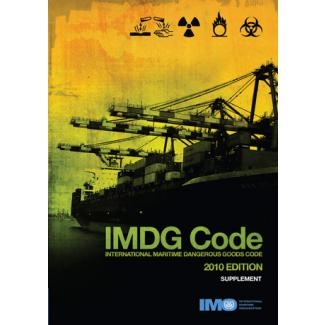

The Code lays down basic principles: detailed recommendations for individual substances, materials and articles, and a number of recommendations for good operational practice, including advice on terminology, packing, labelling, stowage, segregation and handling, and emergency response action. The International Maritime Dangerous Goods Code is the standard guide to all aspects of handling dangerous goods and marine pollutants in sea transport. Amendment 39-18 of the Code is mandatory as from 1 January 2020 but may be applied by Administrations in whole or in part on a voluntary basis from 1 January 2019

It was adopted by IMO's Maritime Safety Committee (MSC) at its ninety-ninth session in May 2018. Amendment 39-18 includes revisions to various sections of the Code and to transport requirements for specific substances. The Code has undergone many changes over the years, in both format and content, in order to keep up with the rapid expansion of the shipping industry. Guidance on the transport of dangerous goods when carried in a private vehicle, or by a foot passenger on a Ro-Ro ship.The International Maritime Dangerous Goods Code is the standard guide to all aspects of handling dangerous goods and marine pollutants in sea transport.Īuthor: International Maritime Organization UK MGN 545 Transportation of dangerous goods (marine).MCA interpretation of the certification and vehicle/container packing certificate requirements of the International Maritime Dangerous Goods (IMDG) Code.UK guidance on the shipping of dangerous goods.UK MGN 30 IMDG code and cargoes carried in cargo transport units.Limited and excepted quantity provisions.proper shipping termsĪppendix B Glossary of terms Information contained in the Dangerous goods list Part 7 Provision concerning transport operations Volume 2ģ.3 Special provisions applicable to certain substances, materials or articlesģ.4 Dangerous goods packed in limited quantitiesģ.5 Dangerous goods packed in excepted quantatiesĪppendix A List of generic and N.O.S.
#Imdg code book portable
Part 6 Construction and testing of packages, IBCs, portable tanks, MECGs and road tank vehicles Part 3 Dangerous goods list – contained in Volume 2 The IMDG goods classes, 1 to 9, explained

Part 1 General Provisions, definitions and trainingĪpplication, Definitions, Training, Security, general provisions for radioactive material The IMDG code comes in two volumes, the first one with general instructions, and the second one containing the specific instructions for each type of dangerous goods. The code was first produced in 1965, but it was only recommendary status until 2004. The carriage of dangerous goods in packaged form shall be in compliance with the relevant provisions of the IMDG Code.” When was the IMDG code first introduced? “Regulation 3 – Requirements for the Carriage of Dangerous Goods Why is does the IMDG code need to be complied with?
#Imdg code book free
While facilitating the free unrestricted movement of such goods.Enhance the safe carriage of dangerous goods.Its only a quick glance, as the code is a complex read, and one worthy of closer look later on this blog. A handy revision guide to the International Maritime Dangerous Goods Code The safe carriage of dangerous goods at seaīefore this blog moved on from the Document of Compliance for Dangerous goods, it will have a quick look at its related code, the IMDG code.


 0 kommentar(er)
0 kommentar(er)
